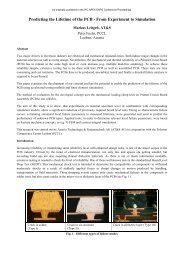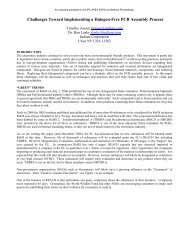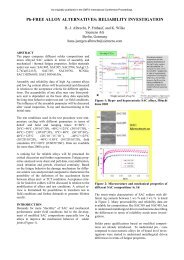evaluation of stencil foil materials, suppliers and ... - IPC Outlook
evaluation of stencil foil materials, suppliers and ... - IPC Outlook
evaluation of stencil foil materials, suppliers and ... - IPC Outlook
You also want an ePaper? Increase the reach of your titles
YUMPU automatically turns print PDFs into web optimized ePapers that Google loves.
As originally published in the SMTA International Conference Proceedings.110%Supplier A SS3 <strong>and</strong> SS40.004" <strong>foil</strong>110%Laser Cut Nickel0.0045" <strong>foil</strong>Transfer Efficiency100%90%80%70%60%50%0.64 0.66 0.68 0.70 0.72 0.74 0.76 0.78 0.80Area Ratio4 ‐ A uncoated4 ‐ A coated3 ‐ A uncoated3 ‐ A coatedFigure 4. Comparison <strong>of</strong> print performance <strong>of</strong> SS #3 <strong>and</strong>SS #4 from same supplierTransfer Efficiency110%100%90%80%70%60%50%Supplier D SS3, SS4 <strong>and</strong> SS50.004" <strong>foil</strong>0.64 0.66 0.68 0.70 0.72 0.74 0.76 0.78 0.80Area Ratio4‐ D uncoated4 ‐ D coated3 ‐ D uncoated3 ‐ D (coated5 ‐ D uncoated5 ‐ D coatedFigure 5. Comparison <strong>of</strong> three types <strong>of</strong> SS from the samesupplierOf the two specialized stainless steels, the one with thesmaller grain size did not appear to release as much materialas the one with the coarser grain size. Replotting the databy supplier (figures 4 <strong>and</strong> 5) shows the trend more clearly.Regardless <strong>of</strong> the <strong>stencil</strong> provider, the <strong>foil</strong>s with the largergrain size released approximately 10% more solder pastethan the <strong>stencil</strong> with the smaller grain size, <strong>and</strong> <strong>stencil</strong>swithout coatings released 8-10% more than <strong>stencil</strong>s withcoatings. Supplier D also submitted a pair <strong>of</strong> <strong>stencil</strong>sproduced with non-specialized SS alloy. Its performance isplotted with the specialized <strong>foil</strong> alloys in figure X. Itappears to perform as well as one <strong>of</strong> the specialized alloys,regardless <strong>of</strong> coating.Due to their relatively larger AR differences, theelectr<strong>of</strong>ormed <strong>foil</strong>s cannot be compared as directly as thesteel <strong>foil</strong>s, but provide interesting observations whenplotted.Transfer Efficiency100%90%80%70%60%50%0.50 0.55 0.60 0.65 0.70 0.75 0.80Area RatioLaser Ni ‐ B uncoatedLaser Ni ‐ B coatedLaser Ni ‐ C uncoatedLaser Ni ‐ C coatedLaser Ni ‐ D uncoatedLaser Ni ‐ D coatedFigure 6. Comparison <strong>of</strong> print performance <strong>of</strong> laser-cutnickel <strong>foil</strong>s from three different <strong>suppliers</strong>Thickness variation in pairs <strong>of</strong> <strong>stencil</strong>s is the primary driverfor differing ARs on submissions from <strong>suppliers</strong> B <strong>and</strong> C, asseen in figure 6. Supplier C’s 0.0045” <strong>foil</strong>s measured0.0047” <strong>and</strong> 0.0050”; supplier B’s measured 0.0037” <strong>and</strong>0.0043”. Consistent thickness on supplier D’s <strong>stencil</strong>smaintained very close AR’s between the two <strong>foil</strong>s. Again,at similar area ratios, the uncoated <strong>stencil</strong> appears to <strong>stencil</strong>release more solder paste than the coated one.Transfer Efficiency130%120%110%100%90%80%70%60%50%Electr<strong>of</strong>ormed Stencils0.0045" <strong>foil</strong>0.40 0.45 0.50 0.55 0.60 0.65 0.70Area RatioEform ‐ B uncoatedEform ‐ B coatedEform ‐ C uncoatedEform ‐ C coatedEform ‐ D uncoatedEform ‐ D coatedFigure 7. Comparison <strong>of</strong> print performance <strong>of</strong>electr<strong>of</strong>ormed <strong>stencil</strong>s from three different <strong>suppliers</strong>.As with the laser-cut nickel <strong>stencil</strong>s, varying <strong>foil</strong> thicknessesdrove varying AR’s. Both <strong>of</strong> supplier C’s <strong>stencil</strong>s measuredabout 0.001” too thick, <strong>and</strong> their apertures measured nearly0.001” too small, driving area ratios down to the 0.45 range,which is considered unacceptable. Supplier B’s <strong>stencil</strong>thicknesses also varied; one measured 0.0002” thicker thanthe other, creating the AR <strong>of</strong>fset seen in figure 7. A similar<strong>of</strong>fset due to a 0.0005” thickness difference was alsoobserved on the same supplier’s 0.004” electr<strong>of</strong>ormed<strong>stencil</strong>s. Again, supplier D’s <strong>foil</strong>s showed very littlevariation, <strong>and</strong> followed trends similar to the SS <strong>foil</strong>s withrespect to transfer efficiency differences between coated <strong>and</strong>uncoated <strong>foil</strong>s on BGA ARs.The electr<strong>of</strong>ormed <strong>foil</strong>s, despite having low area ratios,appeared to deposit more volume than expected, exhibiting100% or better transfer efficiency for a BGA with an AR <strong>of</strong>
















